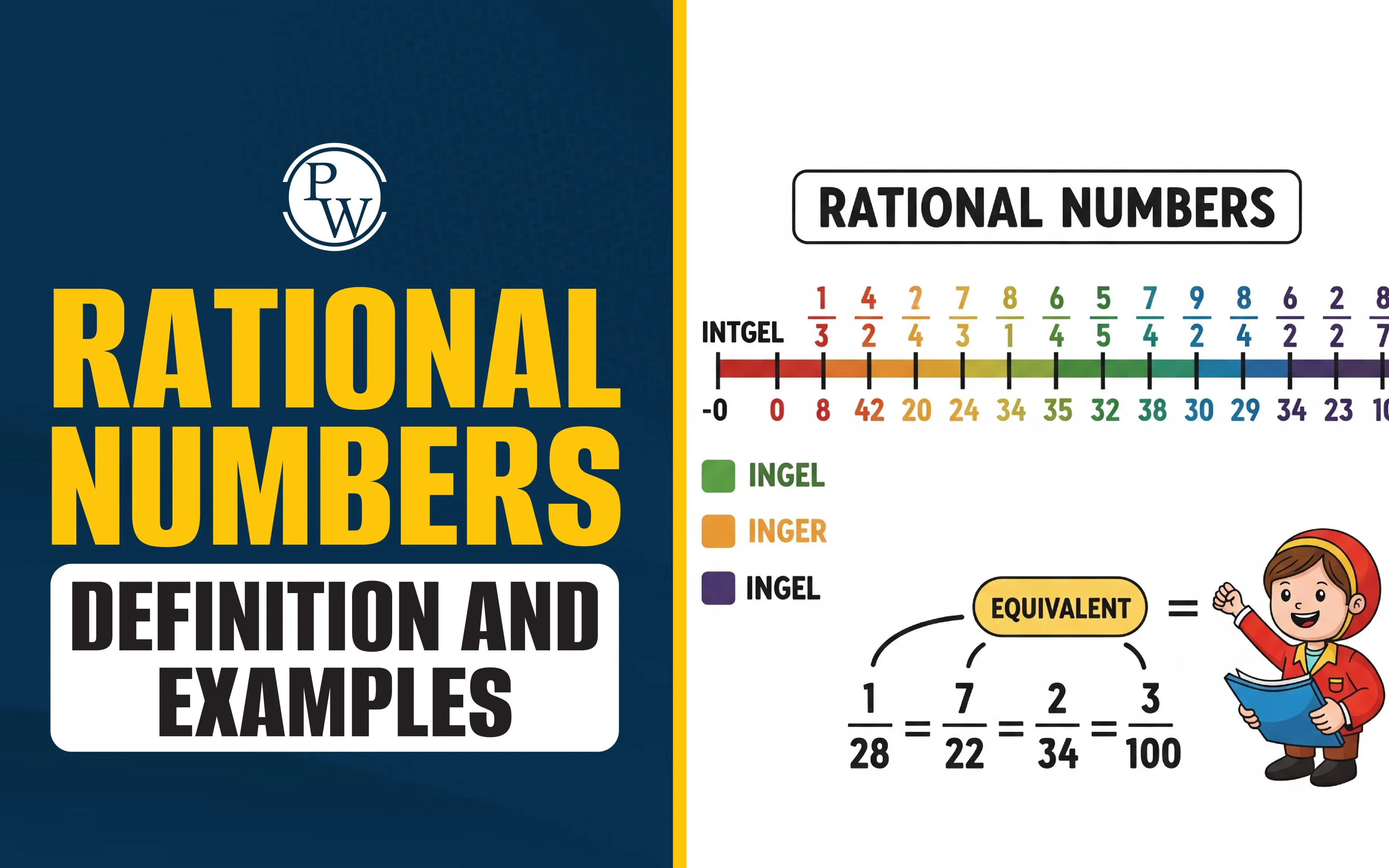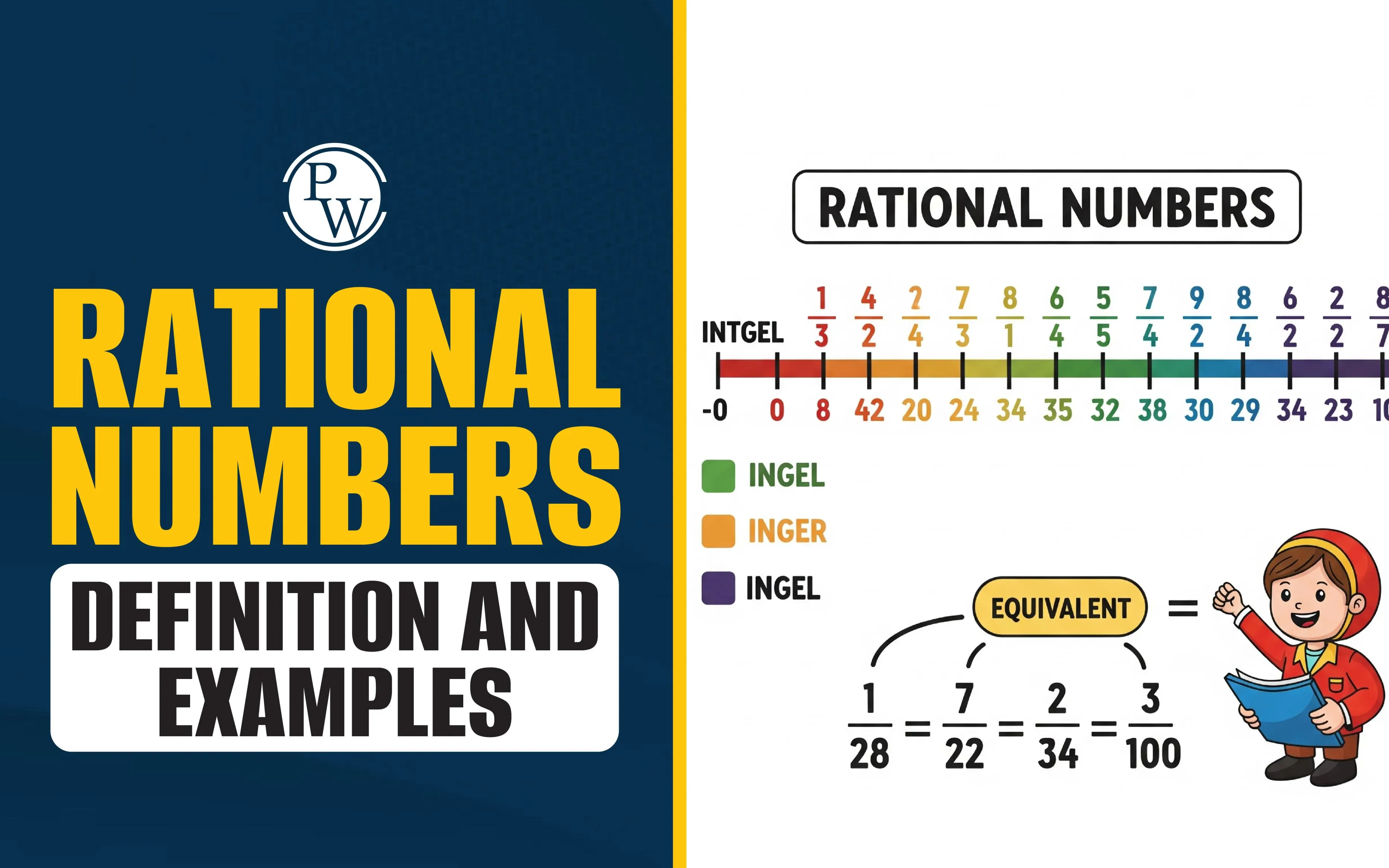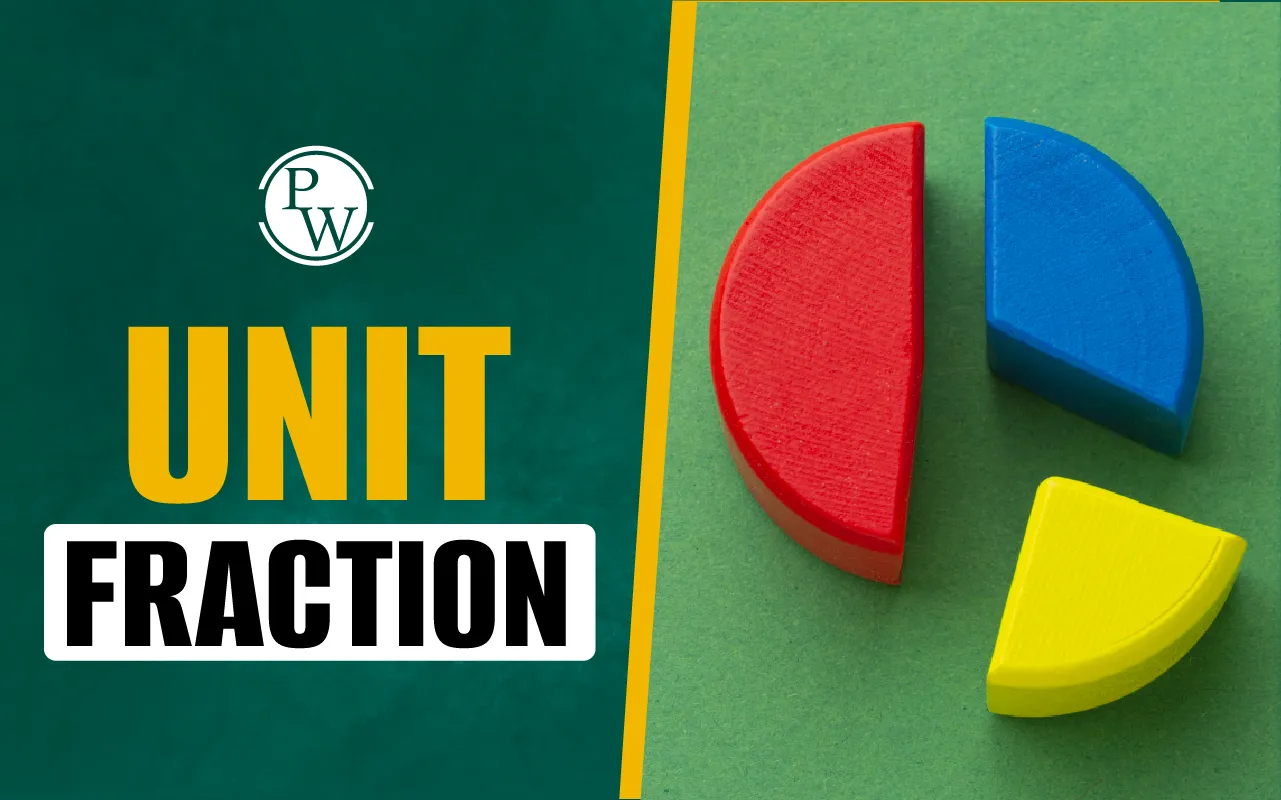

Rational Numbers are numbers that we can write in the form of a fraction like p/q, where p and q are whole numbers or integers, and q is not zero. This means numbers like 1/2, 3/4, and even 0 can be called rational numbers. For example, we can write 0 as 0/1 or 0/5, which makes it a rational number too.
Keep reading to understand what is rational number, its definition, and how to identify them easily in math, along with examples and the important properties of rational numbers.
Read More: Value of Cubes From 1 to 20
What is Rational Number?
The word “rational” comes from the word “ratio,” which means a comparison between two values. So, a rational number is a number that can be written as a ratio or fraction of two integers. In mathematics, it is written as p/q, where p and q are integers, and q is not zero.
Rational numbers include positive numbers, negative numbers, and even zero. For example, 3/2, -5/7, and 0/1 are all rational numbers. These numbers can also be written in decimal form, but only if the decimal stops or repeats. So, 0.25 (which is 1/4) and 0.333... (which is 1/3) are also rational numbers.
Rational Number Definition
As per the rational number definition, it is a type of real number that can be written as a fraction p/q, where both p and q are integers and q ≠ 0. The value of p can be positive, negative, or even zero, but q, the denominator, should never be zero.
This means all numbers that can be shown as a proper fraction or an equivalent decimal form (like 0.5 or 1.25) are called rational numbers. So, whole numbers, fractions, and some decimals all fall under the category of rational numbers as long as they can be written in p/q form with a non-zero denominator.
Read More: Average Formula in Maths
Types of Rational Numbers
There are different types of rational numbers, and all of them can be written in the form p/q, where p and q are integers and q is not zero. Find out the rational number types here:
-
Integers: All integers are rational numbers. For example, -2, 0, and 5 can be written as -2/1, 0/1, and 5/1.
-
Fractions: Numbers like 3/7, -4/9, or 10/3 are rational numbers. Here, both the numerator and denominator are integers, and the denominator is not zero.
-
Terminating Decimals: These are decimal numbers that stop after a few digits. For example, 0.25 = 1/4 or 0.6 = 3/5. These can be changed into fractions, so they are rational numbers.
-
Non-terminating Repeating Decimals: These decimals go on forever but follow a pattern. For instance, 0.333... = 1/3 or 0.121212... = 4/33. Since they repeat in a pattern and can be written as fractions, they are also rational numbers.
These are the main types of rational numbers seen in mathematics. Whether it is an integer, fraction, or decimal, if it fits the form p/q with q ≠ 0, it is a rational number.
Rational Numbers Examples
Now that we have learned what is rational number and how to define it, let us look at some easy rational numbers examples to understand it better. All these numbers can be written in the form of p/q, where p and q are integers and q is not zero.
-
Whole numbers as rational numbers:
-
4 = 4/1
-
0 = 0/1
-
100 = 100/1
So, all whole numbers are rational numbers because they can be written as a fraction.
-
Fractions
-
1/2, -3/5, 7/9 — all these are already in p/q form, so they are rational numbers.
-
Decimals that end or repeat:
-
0.5 = 1/2
-
0.75 = 3/4
-
0.333… = 1/3
Terminating and repeating decimals can also be written as fractions, so they are rational numbers.
-
Negative rational numbers:
-
-2/7, -5/3, 4/(-9)—these are rational numbers where either the numerator or denominator is negative.
-
Positive rational numbers:
-
3/8, 6/11, -4/(-5)- when both numerator and denominator have the same sign, the answer is a positive rational number.
-
Square roots of perfect squares:
-
√16 = 4 = 4/1
-
Since 4 is an integer, it is a rational number.
So, rational numbers examples include fractions, some decimals, whole numbers, and even square roots if they give whole numbers. Most importantly, if we can write it as a fraction with a non-zero denominator, then it is a rational number.
Properties of Rational Numbers
Rational numbers follow some special rules in mathematics. These rules are called their properties. Keep reading to explore some of the important properties of rational numbers, as outlined below:
-
Closure Property: If we add, subtract, or multiply two rational numbers, the answer will also be a rational number. For example, 1/2 + 1/3 = 5/6 (which is also rational).
-
Commutative Property: Rational numbers follow the commutative rule in addition and multiplication. This means:
-
a + b = b + a
-
a × b = b × a
-
Associative Property: When adding or multiplying, changing the group does not change the result.
-
(a + b) + c = a + (b + c)
-
(a × b) × c = a × (b × c)
-
Additive Identity: If we add 0 to any rational number, it stays the same.
-
a + 0 = a
-
Multiplicative Identity: If we multiply any rational number by 1, it stays the same.
-
a × 1 = a
-
Additive Inverse: For every rational number, there is another number that, when added, gives 0.
-
a + (-a) = 0
-
For example, 2/5 + (-2/5) = 0
-
Multiplicative Inverse: For every rational number (except 0), there is another number that, when multiplied, gives 1.
-
a × 1/a = 1
-
For example, 3/4 × 4/3 = 1
-
Equivalent Rational Numbers: If we multiply or divide both the top and bottom of a rational number by the same number (not zero), the value stays the same.
-
For example, 2/3 = (2×2)/(3×2) = 4/6.
Read More: Dimensional Formula
Steps to Identify Rational Numbers in Math
In order to check if a number is a rational number, we can follow these simple steps:
-
Check if it can be written in the form p/q.
-
The first thing to see is if the number can be written as a fraction, like p/q, where p and q are integers and q is not equal to 0. For example, 6 = 6/1, so it is a rational number.
-
Look at the decimal form: If the number is written in decimal form, check:
-
If the decimal ends (terminating), like 0.75 then it is rational.
-
If the decimal repeats a pattern, like 0.444… or 1.232323…, it is also rational.
-
But if the decimal does not stop and does not repeat, like 3.14159265…, it is not rational.
-
Check if it belongs to common number types: Some number types are always rational:
-
Natural numbers: 1, 2, 3...
-
Whole numbers: 0, 1, 2...
-
Integers: -3, 0, 4...
-
Fractions: 2/5, -7/8...
-
Avoid numbers with square roots (unless perfect squares): If a number has a square root that does not give a clean number, it is not rational. For example, √2 = 1.4142135… (non-terminating, non-repeating) Hence, NOT a rational number.
But √9 = 3 is a Rational number.
Read More: Decimal Number System
Rational Numbers vs. Irrational Numbers: What's the Difference?
As we have learned, Rational numbers are numbers that can be written in the form of p/q, where p and q are integers and q is not zero. They include whole numbers, fractions, and decimals that either stop or repeat a pattern. For example, 3/4, 0.25, and -5 are all rational numbers.
On the other hand, irrational numbers cannot be written as a simple fraction. Their decimal form goes on forever without repeating. For example, √2 and π (pi) are irrational numbers because their decimal values do not stop and do not show any pattern.
How to Find Rational Numbers Between Two Rational Numbers?
To find rational numbers between two given rational numbers, two methods are commonly used:
Method 1: Equivalent Fractions
Both numbers are written with the same denominator. Then, the rational numbers that come in between can be listed easily. For example, 1/2 = 3/6 and 4/3 = 8/6. So, the numbers between them are 4/6, 5/6, 6/6, and 7/6.
Method 2: Mean Method
The mean (average) of the two numbers is found by adding them and dividing by 2. This gives a rational number between the two. The same process can be repeated to find more numbers. For example, Mean of 1/2 and 4/3 = 11/12, which lies between them.
Rational Number Examples with Solutions
Example 1: Can 124 be written as a rational number?
Solution:
Yes, 124 can be written as 124/1.
So, 124 is a rational number.
Example 2: Is 0.6 a rational number?
Solution:
Yes, 0.6 is a terminating decimal and can be written as 6/10, which simplifies to 3/5.
So, 0.6 is a rational number.
Example 3: Write the standard form of -12/36.
Solution:
Divide both numerator and denominator by 12:
-12 ÷ 12 = -1
36 ÷ 12 = 3
So, the standard form is -1/3.
Example 4: Find the product of 3/4 and -2/5.
Solution:
(3/4) × (-2/5) = -6/20
Simplify: -6 ÷ 2 = -3, 20 ÷ 2 = 10
So, the final answer is -3/10.
Also Read: Divisibility Rule of 11 with Examples
Strengthen Your Child’s Basics in Just 6 Days with CuriousJr’s Maths Tuition
Does solving math questions during homework often feel confusing or hard for your child? Many students struggle with speed, accuracy, and understanding basic math concepts, which can impact their marks and performance in school.
CuriousJr’s Maths Tuition Online is designed to make math learning simple and enjoyable for students from classes 3rd to 9th. With the help of live interactive classes, visual explanations, and a two-teacher model, students get the support they need to understand every topic at their own pace.
-
These online maths tuition classes cover the school syllabus in a structured way, offer regular homework help, and give personalized attention to each student.
-
Features like performance tracking and regular PTMs also keep parents updated on their child’s progress.
Book a demo class for maths today and see how CuriousJr maths tuition can help your child build a strong foundation in mathematics.
Rational Numbers FAQs
What is a rational number in mathematics?
Is 0 considered a rational number?
Are all integers, whole numbers, and natural numbers rational numbers?
What is the rational number definition?













